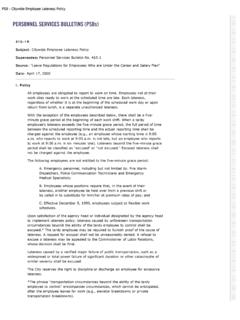Transcription of Flexible schedules and shift work: replacing the '9-to-5 ...
1 Monthly Labor ReviewJune 200033 Flexible SchedulesFlexible schedules and shift work : replacing the 9-to-5 workday? Flexible work hours have gained in prominence,as more than a quarter of all workerscan now vary their schedules ;however, there has been little change in the proportionwho work a shift other than a regular daytime shiftTraditionally, much of the American laborforce has worked in a structured environ-ment, with the work schedule following aset pattern what many people have termed the 9-to-5 workday. Recent studies show that em-ployers are beginning to recognize that manyworkers prefer schedules that allow greaterflexibility in choosing the times they begin andend their workday. Consequently, increasingnumbers and proportions of full-time workersin the United States are able to opt for flexiblework hours, allowing workers to vary the ac-tual times they arrive and leave the work some workers, however, the nature of theirjobs requires that they work a schedule otherthan a regular day shift , what may be termedan alternative shift .
2 1 Examples of such alter-native shift workers are police officers, emer-gency room physicians, and assembly-lineworkers at a contrast to the increasing proportion ofworkers with Flexible work schedules , the inci-dence of shift work has not changed since themid-1980s. If not for the sizable job gains inservice occupations, the overall proportion ofworkers on shift work would have edged downin recent data on Flexible work hours and shiftwork are from information collected in the May1997 supplement to the Current Population Sur-vey (CPS).2 This article uses that supplement toexamine both the incidence and trends in flexiblework hours and alternative shift work and, also,the relationship between the jobs in which peoplework and the prevalence of these digressionsfrom the more traditional 9-to-5 work schedulesIn 1997, more than 25 million workers, or of all full-time wage and salary work -ers varied their work hours to some that Flexible schedule arrangements formany workers are probably informal, as indi-cated by data from the Bureau of Labor Statis-tics Employee Benefits Survey (EBS), in whichemployers provide information about em-ployee access to various types of work -relatedbenefits.
3 The latest EBS data, from 1994 97, showthat less than 6 percent of employees have for-mal Flexible work schedule data show that the proportion of work -ers on Flexible work schedules either formalor informal has more than doubled since1985, when such data were first increase in Flexible work schedules sincethen has been widespread across demographicgroups. The following tabulation shows thepercent of workers, by age and race and His-panic origin, who work Flexible schedules :Thomas M. BeersThomas M. Beersis an economistin the Division of LaborForce Statistics,Bureauof Labor Labor Review June 2000 Flexible , 16 years and older .. origin .. and Hispanic origin:White .. origin .. there has been relatively little difference in the pro-portions of men and women with Flexible schedules duringthe 1985 97 period, whites have been more likely than blacksor Hispanics to have Flexible work schedules .
4 (See table 1.)Occupations. To some degree, these differences reflect thevarying occupational distributions of each of the workergroups. Generally, jobs with higher frequencies of flexiblehours are those in which work can be conducted efficiently,regardless of the workers start and end times. For instance, Flexible work hours are most common among workers in ex-ecutive, administrative, and managerial occupations, and forthose in sales occupations percent and percent,respectively. (See table 2.) The incidence of Flexible workhours is lower for groups of workers in occupations in whichthe nature of the work dictates that it begin and end at settimes, for example, nurses, teachers, police, firefighters, andcertain manufacturing stated, the unique occupational distributions of thevarious demographic groups affect the overall proportion ofworkers on Flexible work schedules within these respectivegroups.
5 For example, as can be seen above, Flexible workhours are considerably more prevalent among whites thaneither blacks or Hispanics. At first glance, this is not surpris-ing because whites are most likely to be in managerial andprofessional specialty occupations, in which Flexible hoursare most common. Furthermore, blacks and Hispanics arehighly represented in the category of operators, fabricators,and laborers. Because of the nature of the work , historically,this category is one that fails to lend itself to the practice offlexible Flexible schedules appear to be closely associ-ated with particular occupations, it is worth investigatingwhether the recent increases in the proportion of workerswith Flexible work schedules reflect an increase in employ-ment in occupations with high occurrences of Flexible workschedules or an increase in the availability of Flexible workhours across occupations.
6 A shift -share analysis was ap-plied to determine the portion of the increase that was due tochanges in occupational employment and the portion thatwas due simply to an increased incidence of Flexible workhours. Less than 3 percentage points of the total increasewere a result of shifts in occupational employment. Thissuggests, therefore, that the majority of the increase wasspurred by the increased incidence of Flexible work sched-ules within occupations; indeed, this phenomenon occurredin nearly every occupational In order to estimate how much of the difference in therate of Flexible work schedules between blacks and whites isaccounted for by differences in occupations, a standardiza-tion was performed. This process showed that if blacks hadthe same occupational distribution as whites (at the mostdetailed level of occupational classification), then the rate ofblack workers on Flexible work schedules would have percent, instead of percent; the difference betweenthe rates for whites and blacks would have been percent-age points instead of percentage points.
7 A similar analy-sis was performed in which the white rates of Flexible work byoccupation were applied to the black occupational distribu-tion. Results show that, in each job category, if blacks wereas likely as whites to be able to vary hours, then the overallblack rate would rise to percent, or percentage pointshigher. This would have reduced the overall difference be-tween blacks and whites to percentage points. Whileeven at the detailed level there may be differences in jobsheld by blacks and whites, these findings suggest that fac-tors other than occupational employment contribute to thedisparity in access to Flexible brief description of Flexible work arrangementsThere are several types of formal Flexible work arrange-ments. One type is a gliding schedule that requires aspecified number of hours of work each day but allowsemployees to vary the time of their arrival and departure,usually around an established set of mandatory corehours.
8 Other types of Flexible work arrangements includevariable-day and variable-week schedules that usuallyrequire a specified number of hours per pay period. Thesetypes of work schedules frequently are grouped underthe umbrella term flexitime. Under these plans, employ-ees are permitted to choose the number of hours theywish to work each day or each week. Credit or compensa-tory time arrangements allow employees who accumu-late overtime hours to apply those hours to future timeoff from work , rather than receiving the overtime rate forthose hours. The presence of one or more of these ar-rangements in the workplace does not necessarily ex-clude the others; many can be used in conjunction withother Flexible work arrangements. (For more information,see Atefah Sadri McCampbell, Benefits AchievedThrough Alternative work schedules , Human ResourcePlanning, 1996, Vol.)
9 Monthly Labor ReviewJune 200035 Flexible schedules of full-time wage and salary workers by selected characteristics, May 1997 All workersMenWomenAgeTotal 16 years and older ..90,54925, ,07314, ,47610, to 19 years ..1, , years and older ..88,90924, ,02314, ,8869, to 24 years ..8,4621, ,9681, , to 34 years ..25,2087, ,7214, ,4862, to 44 years ..26,7557, ,4344, ,3213, to 54 years ..19,5965, ,8063, ,7902, to 64 years ..7,7782, ,4311, , years and older ..1, to 24 years ..10,1022, ,0181, , to 54 years ..71,55920, ,96112, ,5988, years and older ..8,8882, ,0941, , and Hispanic ,68321, ,49513, ,1888, ..10,8842, ,3231, ,5611, origin ..9,6351, ,2831, , statusNever ,7215, ,7463, ,9752, , spouse present ..53,36915, ,75610, ,6135, marital status ..15,4594, ,5711, ,8882, and age of childrenWithout own children under 18.
10 55,25114, ,2668, ,9856, own children under 18 ..35,29810, ,8076, ,4913, own children 6 to 17 ..19,8525, ,8203, ,0322, own children under 6 ..15,4464, ,9863, ,4591, Flexible schedulesWith Flexible schedulesPercentNumberTotalWith Flexible schedulesPercentNumberNOTE: Data relate to the sole or principal job of full-time wage and salaryworkers who were at work during the survey reference week and exclude allself-employed persons, regardless of whether or not their businesses wereincorporated. Data reflect revised population controls used in the CurrentPopulation Survey effective with the January 1997 To a lesser degree, the prevalence of Flexible workschedules also varied by industry. These schedules weremore common among private sector employees than amongthose in the public sector ( percent versus percent)in 1997.














